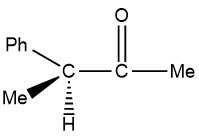The reaction by which benzaldehyde cannot be prepared?
1. 
2. 
3. 
4. 
किस अभिक्रिया द्वारा बेन्जैल्डिहाइड निर्मित नहीं किया जा सकता है?
1.  और के बाद
और के बाद
2. की उपस्थिति में
3. निर्जलीय की उपस्थिति में
4.  और सांद्र HCl
और सांद्र HCl




 और के बाद
और के बाद 

 और सांद्र HCl
और सांद्र HClVanillin, used as a flavouring agent is:
(1) an aliphatic alcohol
(2) an aromatic aldehyde
(3) a hydrocarbon
(4) a carbohydrate
वैनीलिन, एक सुरुचि कर्मक के रूप में इस्तेमाल किया जाता है, है:
1. एक एलिफैटिक एल्कोहॉल
2. एक एरोमैटिक एल्डिहाइड
3. एक हाइड्रोकार्बन
4. एक कार्बोहाइड्रेट
The compound 
by
1. NaCN followed by hydrolysis
2. NaOI followed by H3O+
3. KMnO4 hot followed by hydrolysis
4. K2Cr2O7 followed by H3O+
यौगिक

1. NaCN के बाद जलअपघटन
2. NaOI के बाद H3O+
3. KMnO4 गर्म के बाद जलअपघटन
4. K2Cr2O7 के बाद H3O+
The final product (X) of the following reactions would be
| (1) |  |
| (2) |  |
| (3) |  |
| (4) |  |
निम्नलिखित अभिक्रियाओं का अंतिम उत्पाद (X) होगा
| (1) |  |
| (2) |  |
| (3) |  |
| (4) |  |
The reverse of esterification is known as:
(1) acidolysis
(2) trans-esterification
(3) hydrolysis
(4) neutralization
एस्टरीकरण के उत्क्रम के रूप में जाना जाता है:
1. अम्लांशन
2. विपक्ष -एस्टरीकरण
3. जलअपघटन
4. उदासीनीकरण
A tertiary alcohol H upon acid catalysed dehydration gives a product I. Ozonolysis of I leads to compounds J & K. Compound J upon reaction with KOH gives benzyl alcohol and a compound L, whereas K on reaction with KOH gives only M.
(i) Compound H is formed by the reaction of:
(ii) The structure of compound I is:
(iii) The structures of compounds J,K and L respectively are:
(1)
(2)
(3)
(4)
एक तृतीयक एल्कोहॉल H अम्ल उत्प्रेरित निर्जलीकरण पर एक उत्पाद I देता है। I का ओजोनोअपघटन यौगिकों J और K को देता है। यौगिक J के साथ अभिक्रिया पर KOH बेंज़िल एल्कोहॉल और एक यौगिक L देता है, जबकि K, KOH के साथ अभिक्रिया पर केवल M देता है।
(i) यौगिक H की अभिक्रिया से निर्मित होता है:
(ii) यौगिक I की संरचना है:
(iii) यौगिकों J, K और L की संरचनाएँ क्रमशः हैं:
(a)
(b)
(c)
(d)
Dialkyl cadmium reacts with a compound to form a ketone
The compound is:
(1) acid
(2) acid chloride
(3) ester
(4) CO
डाइएल्किल कैडमियम एक कीटोन निर्मित करने के लिए एक यौगिक के साथ अभिक्रिया करता है
यौगिक है:
(a) अम्ल
(b) अम्ल क्लोराइड
(c) एस्टर
(d) CO
This conversion can be achived by :
1. Dehydration, Hydrolysis
2. Retro aldol and further condensation
3. Perkin condensation & Clemmensen reduction
4. Clemmensen and Perkin condensation
यह रूपांतरण किसके द्वारा प्राप्त किया जा सकता है?
1. निर्जलीकरण, जलअपघटन
2. पूर्वव्यापी एल्डोल और पुन: संघनन
3. पर्किन संघनन और क्लीमेन्सन अपचयन
4. क्लीमेन्सन और पर्किन संघनन
The product/s of the following reaction is
| (1) |  |
| (2) |  |
| (3) |  |
| (4) |  |
निम्नलिखित अभिक्रिया के उत्पाद हैं-
| (1) |  |
| (2) |  |
| (3) |  |
| (4) |  |
















